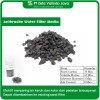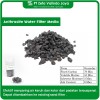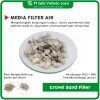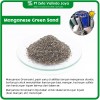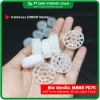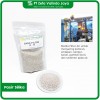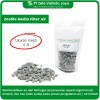Choosing the Right Type of Filter Media for Clean Water and Wastewater Treatment
Choosing the Right Type of Filter Media for Water and Wastewater Treatment

Water treatment is a crucial process for producing clean water that is safe for use and consumption, as well as for managing wastewater before it is discharged into the environment.
In water treatment, whether it is for clean water or wastewater, there are several lengthy processes involved, starting from screening, coagulation and flocculation, sedimentation, biological processes if necessary, followed by filtration, disinfection, and other additional processes.
One of the key components in this extensive water treatment process is filtration, where filter media is used to remove particles and contaminants present in the water. However, not all filter media are suitable for every type of water treatment. The types of filter media, when to use them, and at what stages they are most effective will be explained in detail.
What Is Filter Media?
Filter media refers to the materials used in filtration systems to capture and remove particles contained in water. This filtration process may involve solid particles, organic compounds, or even chemical elements such as heavy metals. Filter media works both physically and chemically, depending on the type of media used.
Types of Filter Media and When to Use
- Silica Sand
Silica sand, often referred to as quartz sand, is used to remove mud, dirt, small particles, and sediment from water. It is usually employed as a pre-filter in the initial stages before entering finer filtration stages. Silica sand is effective for use in household water filtration systems, swimming pool water, or pre-treatment processes in the treatment of clean and industrial wastewater. - Gravel
Gravel is a support media used as a base layer in filtration systems. Its function is to reduce turbidity, suspended solids, blockage by algae, and to reduce suspension and colloids. - Activated Carbon
Activated carbon, derived from coconut shell charcoal, palm shell, or coal, serves to absorb chemicals such as chlorine, organic compounds, odors, and colors from water. Activated carbon has a high absorption capacity and easily clarifies water. It is also effective in removing organic compounds that cannot be filtered out by physical media such as sand. Activated carbon is used in the mid-stage after the physical filtration process and is very important in drinking water treatment and also in clean/wastewater treatment for industries. - Manganese Greensand
Manganese greensand is sand that is activated with manganese dioxide, used to remove iron, manganese, hydrogen sulfide, and other metal contents from water. Manganese greensand is used for medium levels of metal (iron, manganese, etc.). - Manganese Zeolite (Ferolite)
Manganese zeolite (Ferolite) is zeolite (a natural mineral rock) that is activated with manganese. Its function is almost the same as manganese greensand, but zeolite has additional advantages, as it can also act as a natural ion exchanger, thus eliminating hardness from calcium, magnesium, and limestone in water, in addition to its main function of removing iron, manganese, H₂S, and other heavy metals. Manganese zeolite is recommended for heavy metal/iron content levels. - Zeolite
Zeolite is a filter media with ion exchange capabilities, making it effective for removing heavy metals such as iron, manganese, and ammonia from water. Zeolite is ideal for use in the advanced stages of water treatment, especially if the water contains heavy metals or mineral contaminants. Zeolite is widely used in well water treatment systems or industries with high iron or manganese content. - Anthracite
Anthracite is a filter media derived from coal, with a shinier appearance and serves to remove turbidity from water. Anthracite has a lower specific gravity than silica sand, allowing it to be used as a substitute for silica sand in the filtration process or alongside silica sand in multi-media filters. Anthracite can absorb more impurities due to its greater porosity. It is suitable for use in the final stages of the filtration system, particularly in high-velocity water systems that require large capacities without clogging the filter. Anthracite is commonly used in water treatment for large industries or municipal clean water treatment facilities. - Cation and Anion Resins
Resins operate based on the principle of ion exchange, used to remove positively charged ions (such as calcium, magnesium) and negatively charged ions (such as sulfate, nitrate). Resins are important for demineralizing water. They are used in the final stages of treatment, especially when the water needs to be free of minerals for industrial applications such as boilers or cooling systems that require ion-free water. Resins are also often applied in water treatment for electronics, pharmaceuticals, and the food and beverage industry.
Stages of Using Filter Media in Water Treatment Systems
Water treatment consists of several stages, each with specific requirements for the appropriate type of filter media:
- Pre-Treatment Stage In this stage, incoming water still contains many large particles such as mud, sand, and dust. Silica sand and anthracite are used to efficiently filter large particles.
- Mid-Stage Filtration (Chemical and Organic Filtration) After physical particles are filtered, water may still contain chemicals, odors, or organic compounds. Activated carbon plays a significant role here in absorbing these substances.
- Advanced Filtration Stage (Removing Ions and Heavy Metals) In this stage, zeolite, cation/anion resins, and other filter media can be used to remove heavy metals and unwanted minerals, ensuring that the water is safe for further use or disposal into the environment.
- Polishing Stage If necessary, water may go through a final stage using media such as anthracite or resin to produce water of better quality, meeting the required standards.
Benefits of Using the Right Filter Media
Using the appropriate filter media at each stage of water treatment is crucial for:
- Water Treatment Efficiency: Reducing the workload at each stage, thus extending equipment lifespan.
- Better Water Quality: Ensuring that the produced water is free from particles, chemicals, and heavy metals.
- Cost Savings: An optimized system with the right filter media will reduce maintenance costs and frequent filter replacements.
Choosing the right filter media is essential to ensure that water treatment systems operate efficiently and produce high-quality water. By understanding the functions and applications of each type of filter media, you can optimize your water treatment system, whether for drinking water, industrial use, or wastewater treatment.
For more comprehensive water treatment solutions tailored to your needs, feel free to contact PT Zefa Valindo Jaya. We provide a variety of filter media and media replacement services.


